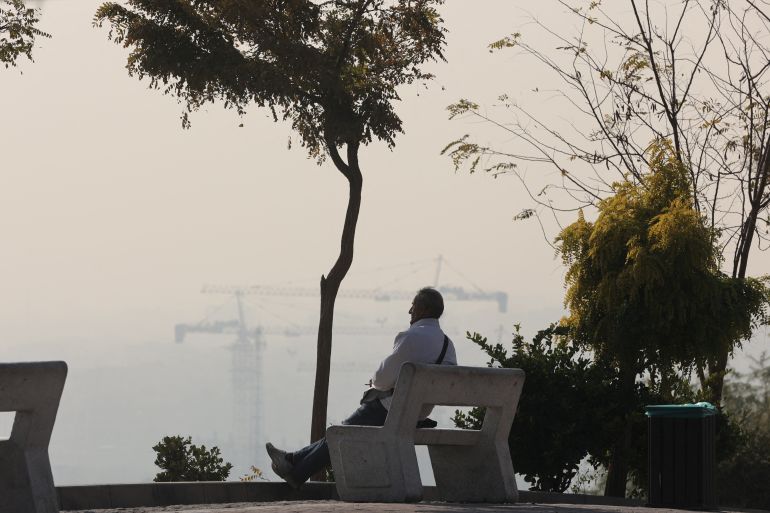Tehran shrouded in thick smog as Iran burns dirty fuel amid energy crisis
Nearly 59,000 Iranians die prematurely due to air pollution in year to March, according to officials.

 Published On 24 Nov 202524 Nov 2025
Published On 24 Nov 202524 Nov 2025
Save
Tehran, Iran – Iranians in the capital and many other cities across the country are breathing in toxic fumes as authorities resort to burning dirty fuel to produce electricity and cope with multiple ongoing crises.
At 14 power plants, authorities for years have burned mazut, a dark residue of petroleum high in sulphur and other impurities, whenever they run out of natural gas to feed the electricity generators.
Recommended Stories
list of 3 itemsend of list
This happens each year due to what observers call chronic mismanagement and ageing infrastructure. It occurs despite heavily sanctioned Iran having the world’s second largest proven natural gas reserves and the third largest crude oil reserves.
Thick and suffocating layers of smog blanketed Tehran on Monday even as traffic was light as the country shut down to observe a religious holiday.
Footage taken on Saturday from the nearly 4,000-metre-high (13,000ft-high) Tochal mountain, adjacent to northern Tehran, showed the capital no longer visible beneath the layers of pollutants.
The city of about 10 million has been among the top five most polluted across the world over the past several days, closely trailing Pakistan’s Lahore and India’s New Delhi.
The pollution index stood at more than 200 early on Monday for a “very unhealthy” classification with a high concentration of PM2.5 airborne particles, which can cause respiratory issues, worsen heart problems and impair lung function, especially for children, the elderly and those with health vulnerabilities.
Advertisement
A “good” index is zero to 50, while a “moderate” is 51 to 100.
State television said Iran’s climate conditions were expected to remain roughly unchanged until the end of the week with hardly any strong wind or rain coming to the rescue. Weather inversions, which trap warmer, smog-filled air close to the surface of the Earth and prevent it from dispersing, are expected to make the situation worse, as do high-emission vehicles and motorcycles.
Air quality has also been rapidly deteriorating in both large and small cities across the country over the past week, further threatening tens of millions of people with dangerous pollutants.
The Iran Meteorological Organization has issued health warnings for heightened air pollution in Tehran, Karaj, Arak, Isfahan, Tabriz, Mashhad, Ahvaz and Urmia. Schools and offices have been shut down in a number of cities. Authorities in Tehran have yet to announce closures despite the hazardous air.

Heavy costs
To avoid more crippling power blackouts, the government of President Masoud Pezeshkian continues to burn mazut, as did his predecessors.
A massive 21 million litres (5.55 million gallons) of the dirty chemical product was being burned every single day by mid-November, according to the semiofficial Fars news agency, affiliated with the Islamic Revolutionary Guard Corps.
Speaking during an exhibition on renewable energy and electricity efficiency in Tehran last week, Energy Minister Abbas Aliabadi confirmed to reporters that power plants will keep burning the heavy fuel oil whenever necessary as winter cold brings more natural gas shortages.
“Mazut-burning power plants are low priority because liquid fuel is valuable and we prefer to use it as a last resort,” he said, without making any mention of the health impacts that using the fuel would entail.
Deputy Health Minister Alireza Raisi told state media this month that 58,975 Iranians had died as a result of breathing in PM2.5 particles during the year that ended in March. That means 161 deaths per day.
The victims died of heart disease, lung cancer, chronic obstructive pulmonary disease, strokes and lower respiratory tract infection directly linked with the air pollution, according to the official.
Raisi said the government has estimated costs of air pollution in the year until March at $17.2bn due to healthcare expenses, premature deaths, lost productivity, school closures and business shutdowns.
Advertisement
In November 2024, Iranian state media had hailed what they called “the government’s brave act” to temporarily stop burning mazut. At the time, government spokeswoman Fatemeh Mohajerani called it replacing “producing poison” with “calculated blackouts”.
As the smog spread across Iran this week, another topic dominating public attention was wildfires that erupted across 8 hectares (20 acres) of forest and mountainous land in the northern provinces.
The fires threatened UNESCO-listed Hyrcanian forests, considered the oldest temperate forest on earth.
The ISNA news agency reported the blazes had been largely brought under control as of Monday.
